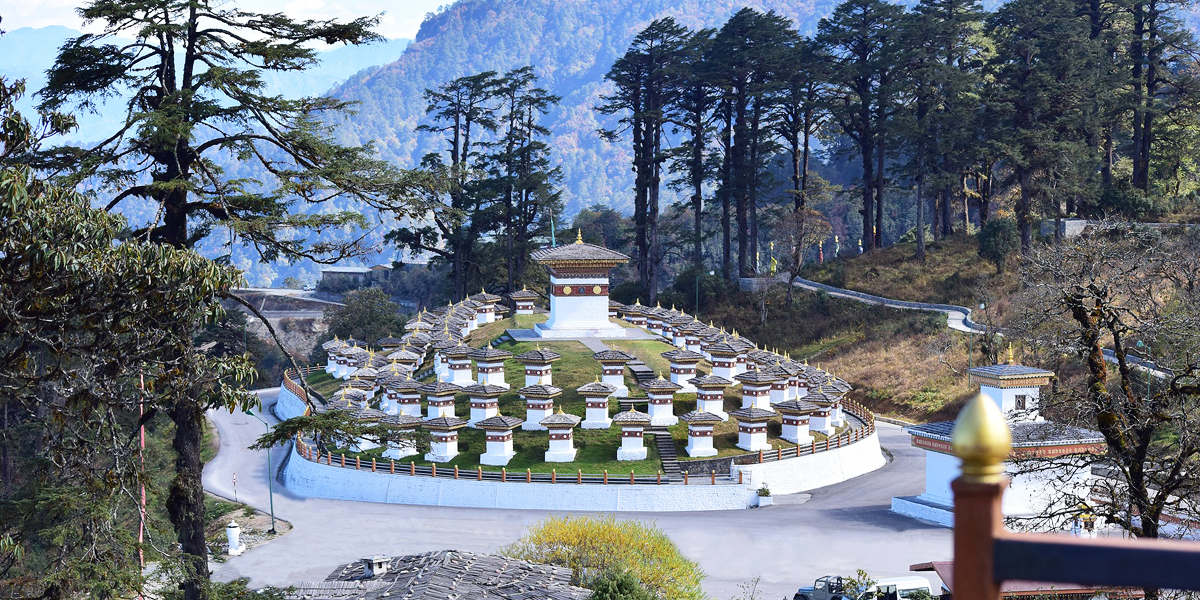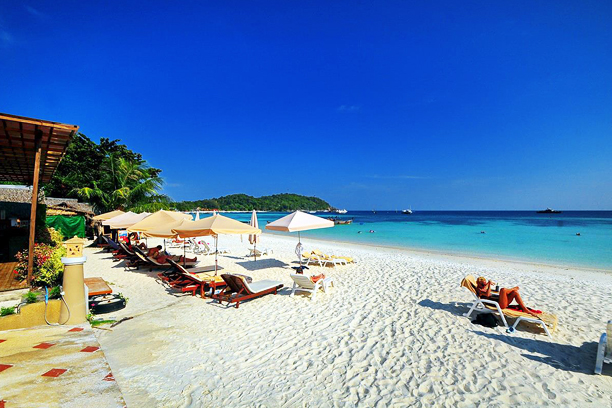Thimphu
Known for its breathtaking natural beauty and unique culture, Thimphu is the administrative capital and largest city of the scenic kingdom of Bhutan.


Thimphu is situated in the Central Bhutan is the capital city of the Himalayan Kingdom Bhutan. Since 1951, the scenic city of Thimphu has been the capital of Bhutan. Surrounded by lofty mountains and shimmering stream of Thimphu Chu, Thimphu has become one of the must visit tourist places in Bhutan. Thimphu with its scenic beauty and traffic free roads has attracted travellers from far and wide.
Thimphu is the most modern city in Bhutan with an abundance of restaurants, internet cafes, nightclubs and shopping centres. However, it still retains its’ cultural identity and values amidst the signs of modernization. Thimphu is one of the few towns in Bhutan that have been equipped with ATM banking facilities and is a good place to stock up on some currency.
There are several attractions in Thimphu such as the National Post Office, the Clock Tower Square, the Motithang Takin Preserve, Tango and Chari Monasteries, Buddha Dordenma, National Memorial Chorten, Centenary Farmer's Market, Semtokha Dzong to name a few. These form the most important tourist attractions in the capital city.
The culture of Bhutan is fully reflected in Thimphu in respect of religion, customs, national dress code, the monastic practices of the monasteries, music, dance, literature and the media. Tshechu is an important festival where mask dances, popularly known as Chams, are performed in the courtyards of the Tashichho Dzong in Thimphu. It is a four-day festival held every year during autumn (September/October), on dates corresponding to the Bhutanese calendar. One of the most curious features of Thimphu is that it is the only capital city in the world that does not use traffic lights. Instead, a few major intersections have policemen standing in elaborately decorated booths (small pavilions), directing traffic with exaggerated hand motions.
Dochula pass is located on the way to Punakha from Thimphu. The pass is a popular location among tourists as it offers a stunning 360 degree panoramic view of the Himalayan mountain range. The view is especially scenic on clear, winter days with snow-capped mountains forming a majestic backdrop to the tranquillity of the 108 chortens gracing the mountain pass.
Bhutanese families enjoy visiting the pass during holidays and weekends to picnic and simply enjoy the scenery. It is common to see families and groups of friends seated amongst the chortens, enjoying a packed lunch and hot tea. For tourists this is an ideal location to capture beautiful pictures of the Himalayan mountain range during clear, warm days.
Tashichho Dzong has been the seat of the government since 1952 and presently houses the throne room and offices of the king, the secretariat and the ministries of home affairs and finance. Other government departments are housed in buildings nearby.
It was first constructed in 1216 A.D. by Lama Gyalwa Lhanangpa where Dechen Phodrang now stands above Thimphu. In 1641, Zhabdrung Ngawang Namgyal acquired it but finding it too small, he built another one, known as the lower Dzong. The original dzong was destroyed by fire in 1771 and everything was moved to the lower dzong. The new building was later expanded several times over the years. It was damaged during an earthquake in 1897 and rebuilt in 1902. King Jigme Dorji Wangchuck had it completely renovated and enlarged over five years after he moved the capital to Thimphu in 1952 in traditional style using neither nails nor written plans.
The dzong is located close to Thimphu town, next to the banks of the Wang Chhu River. It is an impressively large structure, surrounded by well-kept lawns and beautiful gardens.
The name Semtokha literally means “Atop a Demon” and the legend associated with the dzong’s construction tells us that it was built in order to subdue an evil spirit that was harassing travelers in the region. The dzong was modeled after the Gyal Gyad Tshel Institute of Ralung (Tibet) and is quite distinctive as its Utse or central tower has 12 sides.
The dzong houses countless statues and paintings of various Buddhas, deities and religious figures including The Eight Manifestations of Guru Rimpoche, Jampelyang the Bodhisattava of Wisdom, Shakya Gyalpo the Buddha of Compassion and many more all carved and painted in exquisite detail.
The National Memorial Chorten was built in memory of Third Druk Gyalpo and is dedicated to World Peace. The chorten is a large white structure crowned with a golden spire.
It is located close to the center of Thimphu city and is one of its most iconic monuments. Visitors will find elderly Bhutanese people circumambulating the Chorten throughout the day. Chorten literally means ‘Seat of Faith’ and Buddhists often call such monuments, the ‘Mind of Buddha’. The Chorten is an extraordinary example of Buddhist architecture and artwork with its gorgeous paintings and intricate sculptures.
The Buddha Dordenma is located atop a hill in Kuenselphodrang Nature Park and overlooks the Southern entrance to Thimphu Valley. The statue fulfils an ancient prophecy dating back to the 8th century A.D that was discovered by Terton Pema Lingpa (Religious Treasure Discoverer) and is said to emanate an aura of peace and happiness to the entire world.
This massive statue of Shakyamuni measures in at a height of 51.5 m, making it one of the largest statues of Buddha in the world. The statue is made of bronze and is gilded in gold. 125,000 smaller Buddha statues have been placed within the Buddha Dordenma statue; 100,000 statues of which are 8-inches-tall and 25,000 statues of which are 12 inches tall. Each of these thousands of Buddhas has also been cast in bronze and gilded. The throne that the Buddha Dordenma sits upon is a large meditation hall.
Located in the capital city of Thimphu, this museum was established in 2001 and provides visitors and tourists with fascinating insights into the Bhutanese material culture and way of life. The Folk Heritage Museum is set inside a three storied, 19th century traditional house.
The museum gives you a glimpse of the traditional Bhutanese lifestyle, in addition to artifacts from rural households; it also displays an impressive collection of typical household objects, tools and equipment. The museum also organizes regular demonstrations of rural traditions, skills, habits and customs as well as hosting educational programs for children.
Choice of food is most varied in Thimphu among all Bhutan towns. There are plenty of restaurants in the main town and almost all hotels have running restaurants in the Bhutan capital. However regional food for Indian tourists is not available in most places. Pure vegetarian restaurants are also highly limited. Most restaurants serve both vegetarian non-vegetarian food. Most restaurants serve Beef, pork and chicken dishes among non-vegetarian items. Halal meat is also rare. Continental food is available in most upmarket restaurants and hotels. Indian dishes are available in most hotels and restaurants in the main town. Mushroom and chili dishes are quite popular here prepared with country cheese.
Bhutanese dishes include ‘Ema Datshi’ arguably the most popular dish here. It is prepared with cheese and chili and may be quite hot for most foreigners. Red rice is the popular staple food here. A chicken item such as ‘Jasha Maru’ is very popular.
Most Bhutanese handicrafts are not made for a tourist market, so they retain their authenticity. The prices tend to be more expensive than those of goods found in other Asian countries. Thimphu has an excellent selection of handicraft shops selling high-quality traditional paintings, textiles, jewelry, masks, and carpets. Several shops on Norzin Lam have good selections of the textiles, both ready-made and handmade kiras and khos. The philatelic shop at the post office has a fine display of stamps in vibrant colours and vivid images ranging from holographic images, to Walt Disney, to First Day Issues. Even if you’re not a collector, it’s still well worth the visit.
In consideration of natural scenery and comfort level for travel, the best time to visit Bhutan is from March to May in spring and from September to November in fall, when the weather and climate is most mild and pleasant for travelling and temperature on day time is moderate between 20~28 degrees Celsius.
Thimphu has a very hilly terrain which doesn’t allow the city to have an airport. The closest airport is the Paro International airport. This also happens to be the only international airport in the country. Paro is serviced primarily by Druk Air, the state owned airline. Druk Air has routes to and from Bagdogra, Bangkok-Suvarnabhumi, Delhi, Dhaka, Singapore, Kathmandu, Guwahati, Kolkata, Mumbai, among others. It has domestic destinations within Bhutan as well, like Gelephu and Jakar. Bhutan Airlines, a privately owned airline started operations to and from some of the same routes as mentioned above. Another charter airline that services this airport is Buddha air which runs services from Kathmandu only.
Thimphu is well connected by buses, especially from the cities across the border in India. Bhutan government runs buses from the Esplanade depot in Kolkata to Phuentsholing which takes about a day and costs around 400 rupees. Another popular route is from Siliguri to Phuentsholing that takes about 6 hours. Phuentsholing is a compulsory stopover and buses have to be changed from here. Bhutan government has buses from Siliguri to Phuentsholing as well along with local private operators. Another option to reach Phuentsholing by bus is from the Hashimara station which is only a few kilometers away. Buses for Thimphu leave every half an hour from Phuentsholing after the entry procedure formalities are completed by the visitors and necessary permits obtained from the Bhutan government officials.
Bhutan doesn’t have a rail network.

Book with Us and Get Best Deals in
*Terms and Conditions applied